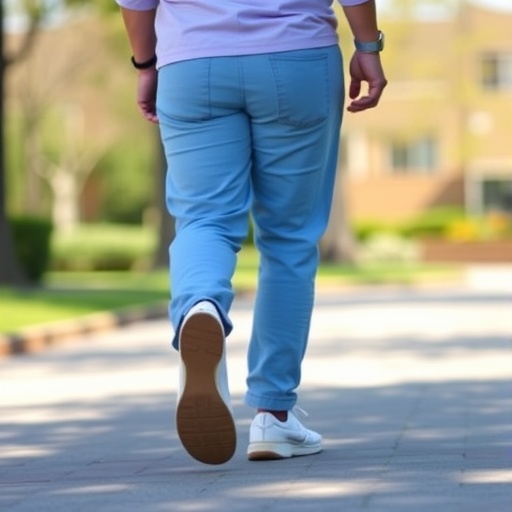In a striking new study published in BMC Geriatrics, researchers have uncovered a compelling link between gait speed and the risk of developing diabetes mellitus among older adults. This groundbreaking research sheds light on a critical aspect of geriatric health, offering insights that could reshape how we view mobility and metabolic health in aging populations. Leveraging rich data from the China Health and Retirement Longitudinal Study (CHARLS), the findings could not only enhance our understanding of diabetes risk but also inform future interventions aimed at this vulnerable demographic.
Gait speed, often seen as a simple measure of physical performance, has important implications for overall health, particularly in older adults. The study led by Bai et al. meticulously examines how variations in walking speed correlate with the incidence of diabetes. Typically, slower gait speeds have been associated with a range of health complications, and this research deepens that connection, highlighting the significance of maintaining mobility for metabolic health.
The researchers utilized sophisticated statistical methods to analyze data from thousands of participants aged 60 and older. By focusing on gait speed—defined as the distance walked in a specified timeframe—they were able to draw meaningful associations that underscore the practical implications of this mobility metric. The result is a nuanced understanding that aids in predicting diabetes development while providing a framework for preventive healthcare strategies in the aging population.
Interestingly, the findings indicate that even moderate declines in gait speed are linked to heightened diabetes risk. This emphasizes that maintaining a brisk walking pace may contribute significantly to preventing metabolic disturbances. As older adults experience age-related changes in muscle mass, strength, and overall mobility, their gait speed serves as a pivotal indicator of health status, making routine assessments of this parameter increasingly vital.
The ramifications of these findings cannot be overstated. Diabetes has become a predominant health concern worldwide, particularly in older adults, where its prevalence continues to rise alarmingly. Diabetes not only contributes to diminished quality of life but also increases vulnerability to other chronic conditions, including cardiovascular disease and cognitive decline. Therefore, understanding the predictors of diabetes in the elderly is crucial for public health strategies aimed at reducing these risks.
Moreover, the association between gait speed and diabetes risk might hold potential for healthcare providers to craft individualized intervention strategies. By routinely evaluating an older adult’s walking speed, healthcare professionals could implement preventive measures tailored to those at higher risk, such as physical therapy interventions focusing on gait training and strength-building exercises. This can ultimately lead to enhanced quality of life and autonomy for older individuals.
The study’s cross-sectional nature does prompt questions regarding causation versus correlation. While slower gait speed is correlated with higher diabetes risk, further longitudinal studies are necessary to determine whether changes in gait speed over time can serve as a direct predictor of diabetes onset. Comparatively, understanding the mechanics involved in this relationship could unlock new avenues for research focused on preventative care.
In light of these insights, policymakers and public health officials may want to consider initiatives that promote physical activity among older populations. Community-based exercise programs designed specifically for seniors can foster not only improved mobility but also a reduction in chronic disease risk. By prioritizing such interventions, communities can work towards enhancing the overall health of their aging residents.
Additionally, researchers argue that further investigation into other lifestyle factors played significant roles alongside gait speed. This could include dietary habits, social engagement, and pre-existing health conditions, all of which contribute to an individual’s risk profile for diabetes. Understanding these factors holistically is essential for designing effective intervention strategies that go beyond merely promoting mobility.
Furthermore, given the digital health landscape’s evolution, integrating technology to monitor walking speed could be a game-changer. Wearable devices that track gait speed in real-time can allow individuals and their healthcare providers to detect changes quickly, thereby facilitating prompt interventions before serious complications arise. Such innovations could transform eldercare, placing emphasis on proactive management of metabolic health.
To sum up, the exploration of the relationship between gait speed and diabetes risk opens up crucial discussions in geriatric health. As the elderly population continues to grow globally, strategies aimed at protecting metabolic health are more important than ever. By focusing on maintaining mobility, we may not only reduce the incidence of diabetes but also enhance the overall quality of life for older adults.
In conclusion, the findings presented by Bai and colleagues underscore the intrinsic link between physical function and metabolic health. The implications for healthcare delivery, public health policy, and geriatric care are profound. As researchers continue to delve into the nuances of this relationship, it is anticipated that novel strategies will emerge to combat diabetes and promote active, healthy aging in our global society.
Subject of Research: Association of gait speed with diabetes risk in older adults.
Article Title: Association of gait speed with risk of diabetes mellitus among older adults: findings from the China health and retirement longitudinal study.
Article References:
Bai, Y., Wu, R., Zhang, F. et al. Association of gait speed with risk of diabetes mellitus among older adults: findings from the China health and retirement longitudinal study.
BMC Geriatr 25, 806 (2025). https://doi.org/10.1186/s12877-025-06481-9
Image Credits: AI Generated
DOI: 10.1186/s12877-025-06481-9
Keywords: gait speed, diabetes mellitus, older adults, mobility, metabolic health, geriatric health, China Health and Retirement Longitudinal Study.




